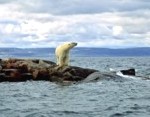 GENEVA – Polar bears and hippos have joined the ranks of species threatened with extinction from climate change, unregulated hunting and other man-made dangers, a leading environmental agency said on Tuesday. The World Conservation Union, or IUCN, said more than 16,000 species of animals and plants were at risk of disappearing, including one in four mammals and one in eight birds.
GENEVA – Polar bears and hippos have joined the ranks of species threatened with extinction from climate change, unregulated hunting and other man-made dangers, a leading environmental agency said on Tuesday. The World Conservation Union, or IUCN, said more than 16,000 species of animals and plants were at risk of disappearing, including one in four mammals and one in eight birds. It added 530 species to its "Red List" of endangered species since the last version released two years ago.
China, Brazil, Australia and Mexico are home to large numbers of threatened species, said the IUCN, whose members include 81 governments, more than 850 non-governmental groups and some 10,000 scientists from around the world.
It said countries worldwide needed to boost efforts to preserve biodiversity through reduced emissions, tighter fishing and hunting controls, and other measures.
Without a reversal of global warming trends, it predicted polar bear populations would drop more than 30 percent in the next 45 years as melted ice caps deprive the animals of their habitat.
It classified the polar bear as a "vulnerable" species, one step down from "endangered" in its ranking of extinction risk. The polar bear was previously called a less-severe "conservation dependent" species.
The common hippo was also ranked as vulnerable, "primarily because of a catastrophic decline in the Democratic Republic of Congo," the IUCN said.
Unrestricted hunting has caused a 95 percent decline in the central African country's hippo population since 1994, it said. The animal has never before been listed as threatened.
"CRITICALLY ENDANGERED"
Dama gazelles, once the most populous species of gazelle in the Sahara desert, are now "critically endangered" as a result of poaching, the report found.
More than half of the Mediterranean's 25 endemic species of freshwater fish were deemed to be at risk of extinction, along with one in four of East Africa's freshwater fish.
In Malawi, where freshwater fish account for 70 percent of the animal protein that humans eat, the numbers of lake trout in Lake Malawi have halved in the past decade.
"This could have major commercial and dietary consequences for the region," the IUCN said.
Ocean life was also cited as vulnerable. Of 547 species of sharks and rays assessed in the report, 20 percent were found to be at risk of extinction. Bottom-dwelling species also logged huge declines as fisheries have reached into ever-deeper waters.
"Populations are destined to decline in the absence of international catch limits," the report said, adding regulations on mesh size and non-fishing areas could help restore stocks.
World Conservation Union Director General Achim Steiner said resurgent populations of white-tailed eagles in Europe showed that protective measures can protect vulnerable species.



